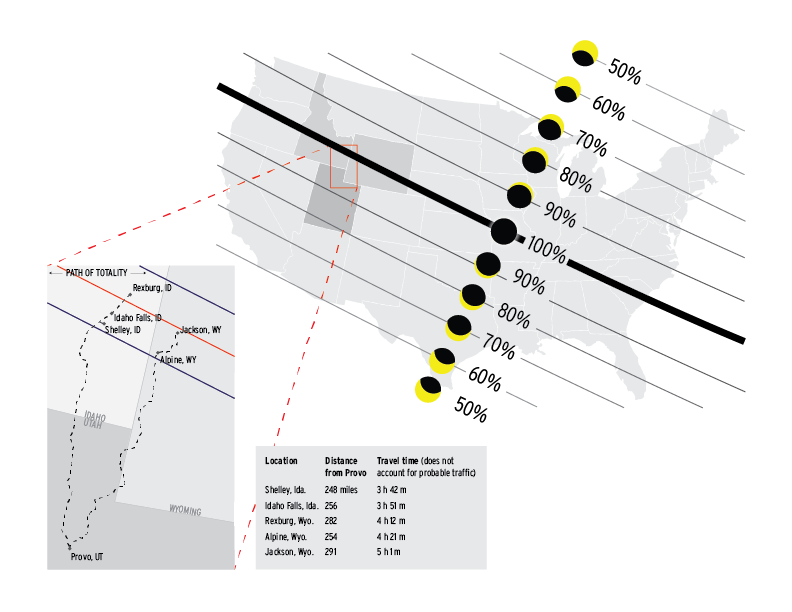
A total solar eclipse will be visible in Eastern Idaho at 11:33 a.m. on Aug. 21, clear skies permitting.
A total solar eclipse occurs when the moon’s orbit brings it between the sun and earth at an angle where the moon blocks the sun’s light and casts its shadow on the earth.
The sun’s corona, which is an aura of plasma that surrounds the sun and is normally not visible because of the bright photosphere of the sun, becomes visible during a total solar eclipse, according to BYU Idaho professor Brian Tonks.
Visitors traveling to view this rare occurrence in the Rexburg, Idaho, area, will have a few things they will need to consider.
Travel
Eclipse viewers should travel and arrive well in advance of the eclipse, according to Captain Randy Lewis of the Rexburg Police Department.
“We worry about people that might be running late, and it’s getting time for the eclipse and they’re speeding,” he said.
Lewis said it is important to park only where parking is permitted. When driving, particularly after the eclipse, he urged eclipse viewers to be courteous and patient and not to speed.
Lewis said he is most concerned about everybody trying to rush home at the same time. If possible, try to have a flexible schedule and leave a few hours after the eclipse.
Additionally, Bureau of Land Management fire information officer Kelsey Griffee said it is important to park so the roads are not blocked in case emergency responders need to access certain areas.
Safety and Health
One of the biggest health risks of the event is not having proper ISO-certified eyewear, according to Geri Rackow, District director at Eastern Idaho Public Health.
Any eyewear used should have certification that designates the product as meeting the ISO 12312-2 international standard and have the manufacturer’s name and address printed on the product, according to a press release from the Utah Optometric Association.
Eyewear should not be used if it is older than three years, if it has scratched or wrinkled lenses or if it is homemade, according to the release.
“Anytime you’re looking at the sun, you should have eye gear on,” said Mimi Taylor, the public information officer for Eastern Idaho Public Health.
This includes the time leading up to the eclipse and afterward, she said.
The potential crowds of people from across the country and even across the globe also present a risk of the spread of infectious disease, Taylor said.
“The best way to protect ourselves is to make sure we’re up to date on our vaccines,” Taylor said.
She also said “good, old-fashioned hand washing” is a vital way to protect against disease.
Eclipse viewers should be aware of potentially dangerous critters, including bears, ticks, bats, snakes and mosquitoes, according to a press release from the Eastern Idaho Public Health Department. Wear sunscreen and insect repellent, bring cash in case credit and debit cards do not work and carry a first-aid kit, the release advised.
For safety, Lewis advises visitors to keep valuables on them, lock their vehicles and stay aware of their surroundings.
“Here in Rexburg we don’t realize crime happens as much as it does,” he said.
Fire
Check for the latest update on fire restrictions before building a fire. The end of August is normally the highest fire danger time, according to Griffee. She said if campfires are allowed, they need to be completely extinguished after burning.
Griffee also said to be cautious of vehicle-caused fires. She advised people walk around their vehicle before traveling to make sure it is properly maintained and no metal or exhaust pipes are dragging. Trailer chains should also be tied up and secured, she said.
In addition, Griffee said people should avoid parking on dry grasses because the heat on the bottom of vehicles often ignites the grass.
“That’s something that people tend to forget,” she said.
Be sure to stay up to date on any fires by following @BLMIdahoFire. If there is a fire, Griffee advises people to immediately get to a safe location and call 911.
Food and Water
Because of the massive influx of people, Eastern Idaho Public Health advises people to pack a few days’ worth of food. If purchasing food from local vendors, be sure to verify that they have either a license or an exemption from Eastern Idaho Public Health.
Kellye Eager, director of the environmental health division at Eastern Idaho Public Health, said it’s important for people to know the source of any water they drink. Packing bottled water can be a good way to ensure a water source is clean, and it may be helpful in the event of a shortage.
Viewing Locations and Lodging
Public spaces, such as parks and state and federal public lands, can be used to view the eclipse. Rexburg and Sugar City are also offering RV camping in two locations. Other lodging options can be searched for here.
Communication
It is possible cell service will be down in the area, so be sure to communicate plans with others ahead of time. Don’t plan to rely on cell phones before and after the eclipse.
Once-in-a-Lifetime
According to BYU Idaho professor Brian Tonks, this is the first eclipse to cross the entire country since 1918, and another one like it will not occur in Idaho for over 150 years.
“My experience and research say that the totality experience is very different than the partial experience,” Tonks said in an email. “If possible, come to the totality zone.”
More Info on the Eclipse
Eastern Idaho Public Health Eclipse Information and Facebook Page
Idaho Fire Info and Idaho BLM Fire Twitter Account




